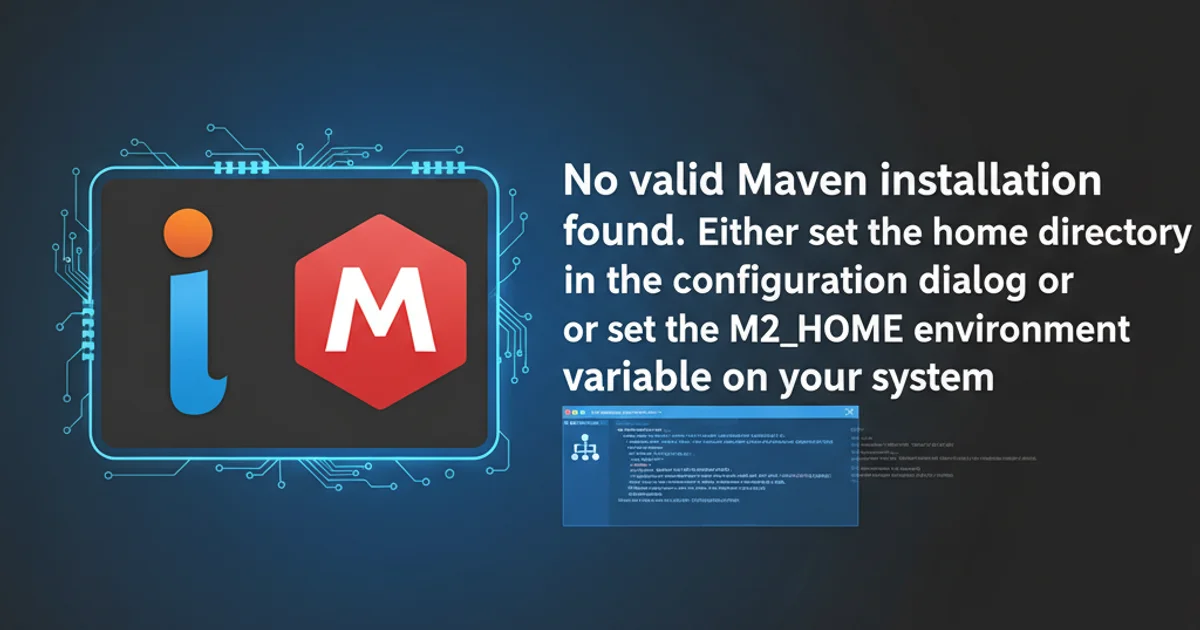No valid Maven installation found. Either set the home directory in the configuration dialog or s...
Categories:
Resolving 'No Valid Maven Installation Found' in IntelliJ IDEA

This article guides you through troubleshooting and fixing the common 'No valid Maven installation found' error in IntelliJ IDEA, ensuring your projects build correctly.
Encountering the error message "No valid Maven installation found. Either set the home directory in the configuration dialog or set the M2_HOME environment variable on your system" is a common hurdle for developers working with Maven projects in IntelliJ IDEA. This issue typically arises when IntelliJ IDEA cannot locate your Maven installation, preventing it from building or managing your project dependencies. This guide will walk you through the necessary steps to resolve this problem, covering both IntelliJ IDEA's internal settings and system-wide environment variables.
Understanding the Error
The error message clearly indicates that IntelliJ IDEA needs to know where your Maven installation resides. Maven is a powerful project management tool that handles dependencies, builds, and documentation for Java projects. For IntelliJ IDEA to leverage Maven's capabilities, it must be configured to point to a valid Maven home directory. This can be achieved in two primary ways:
- IntelliJ IDEA's Configuration Dialog: This is the preferred method for most users, allowing you to specify the Maven home directory directly within the IDE's settings.
- M2_HOME Environment Variable: A system-wide environment variable that points to your Maven installation. IntelliJ IDEA can pick this up if configured correctly, but direct IDE configuration often overrides or is preferred over system variables for specific projects.
flowchart TD
A["IntelliJ IDEA Project"] --> B{"Maven Build Triggered?"}
B -- Yes --> C{"Maven Home Configured in IDEA?"}
C -- Yes --> D["Use IDEA's Maven Settings"]
C -- No --> E{"M2_HOME Environment Variable Set?"}
E -- Yes --> F["Use M2_HOME"]
E -- No --> G["Error: No Valid Maven Installation Found"]
D --> H["Maven Build Successful"]
F --> HDecision flow for Maven installation detection in IntelliJ IDEA
Method 1: Configuring Maven in IntelliJ IDEA
This is the most straightforward and recommended approach. IntelliJ IDEA provides a dedicated settings panel to configure your Maven installation. You can choose to use the Maven version bundled with IntelliJ IDEA or specify a custom local installation.
1. Open IntelliJ IDEA Settings
Go to File > Settings (on Windows/Linux) or IntelliJ IDEA > Preferences (on macOS).
2. Navigate to Maven Settings
In the settings dialog, search for 'Maven' or navigate to Build, Execution, Deployment > Build Tools > Maven.
3. Configure Maven Home Directory
Under the Maven home directory section, you have two options:
* **Bundled (Maven 3)**: This option uses the Maven version that comes integrated with IntelliJ IDEA. This is often the easiest solution if you don't require a specific external Maven version.
* **Maven home directory**: Select this option and click the `...` button to browse to your local Maven installation directory. This should be the root directory of your Maven installation (e.g., `C:\apache-maven-3.8.6` on Windows or `/usr/local/apache-maven-3.8.6` on macOS/Linux), not the `bin` directory within it.
4. Apply Changes and Reimport Project
Click Apply and then OK to save your settings. After configuring, it's often necessary to reimport your Maven project. You can do this by right-clicking on your project in the Project tool window, then selecting Maven > Reload Project.
apache-maven-3.8.6), not the bin subdirectory. IntelliJ IDEA expects the parent directory.Method 2: Setting the M2_HOME Environment Variable
If you prefer a system-wide Maven installation or if the IntelliJ IDEA configuration doesn't resolve the issue, you can set the M2_HOME environment variable. This method makes Maven accessible from any command line and can be picked up by IntelliJ IDEA.
1. Download Maven (if not already installed)
If you don't have Maven installed, download the binary zip archive from the official Apache Maven website. Extract it to a suitable location (e.g., C:\apache-maven-3.8.6 on Windows or /usr/local/apache-maven-3.8.6 on macOS/Linux).
2. Set M2_HOME Environment Variable
This step varies by operating system:
* **Windows**: Go to `Control Panel` > `System and Security` > `System` > `Advanced system settings` > `Environment Variables...`. Under 'System variables', click `New...` and set `Variable name` to `M2_HOME` and `Variable value` to the path of your Maven installation (e.g., `C:\apache-maven-3.8.6`).
* **macOS/Linux**: Open your shell configuration file (e.g., `~/.bash_profile`, `~/.zshrc`, or `~/.bashrc`) and add the following lines (adjust the path as necessary):
```bash
export M2_HOME="/usr/local/apache-maven-3.8.6"
export PATH="$M2_HOME/bin:$PATH"
```
After adding, run `source ~/.bash_profile` (or your respective file) to apply the changes.
3. Verify Installation
Open a new terminal or command prompt and type mvn -v. You should see output indicating the Maven version, Java version, and OS details. If you see this, Maven is correctly installed and configured system-wide.
4. Restart IntelliJ IDEA
After setting system environment variables, it's crucial to restart IntelliJ IDEA completely for it to pick up the new variables. Then, reimport your Maven project as described in Method 1.
export M2_HOME="/usr/local/apache-maven-3.8.6"
export PATH="$M2_HOME/bin:$PATH"
mvn -v
Example of setting M2_HOME and PATH variables on macOS/Linux and verifying Maven installation.
Troubleshooting Tips
If the above methods don't immediately resolve your issue, consider these additional troubleshooting steps:
- Check Maven Wrapper: If your project uses a Maven Wrapper (
mvnwormvnw.cmd), IntelliJ IDEA might be configured to use that instead of a global Maven installation. CheckSettings/Preferences>Build, Execution, Deployment>Build Tools>Maven>Maven Wrapper. - Invalid Maven Settings File: Ensure your
settings.xmlfile (usually in~/.m2/or$M2_HOME/conf/) is valid and not corrupted. IntelliJ IDEA allows you to specify a customsettings.xmlpath in the Maven settings. - Firewall/Proxy Issues: If Maven needs to download dependencies, ensure your firewall or proxy settings are not blocking access to Maven repositories. This is less common for the 'no installation found' error but can cause subsequent build failures.
- Corrupted IntelliJ IDEA Installation: In rare cases, a corrupted IntelliJ IDEA installation might be the culprit. Try reinstalling the IDE.
- Project-Specific Maven Settings: Sometimes, a project might override global Maven settings. Check the
.idea/maven.xmlfile within your project directory (though usually, you'd configure this via the UI).